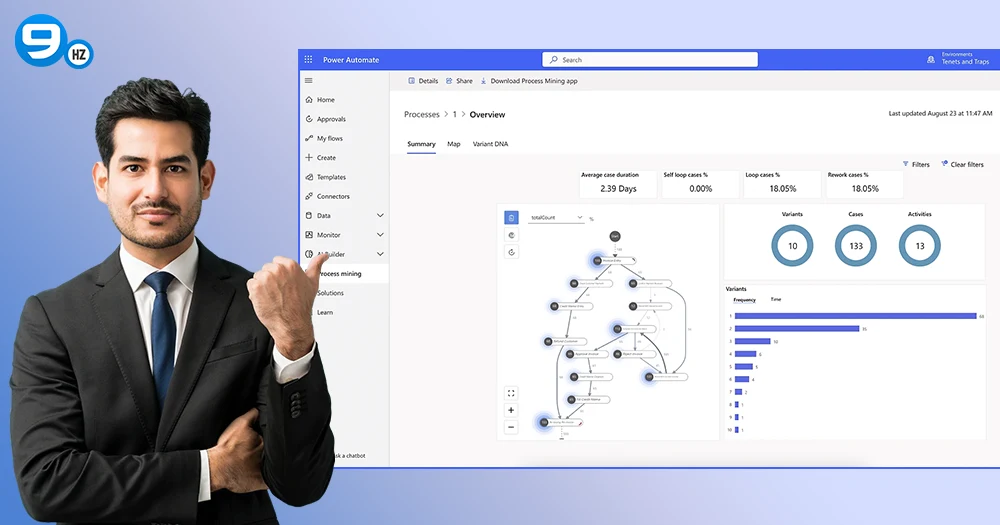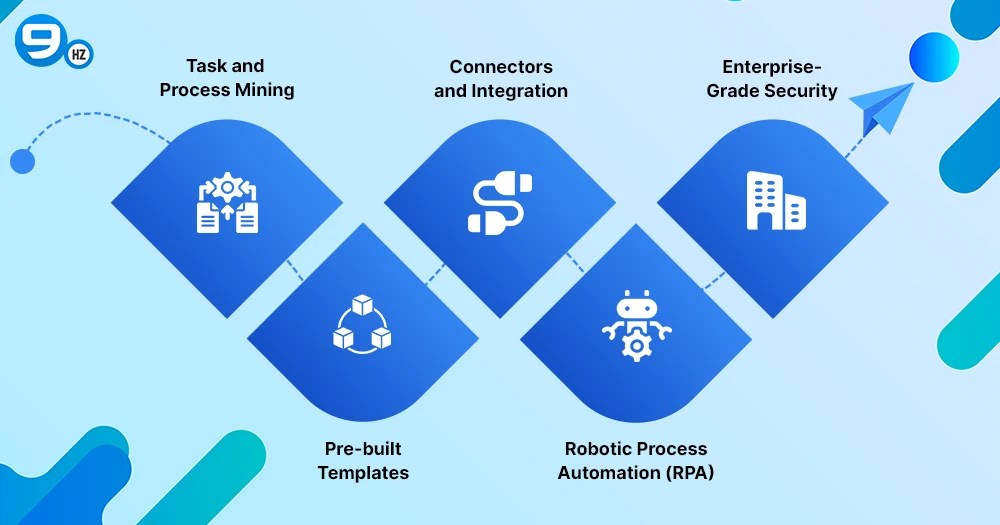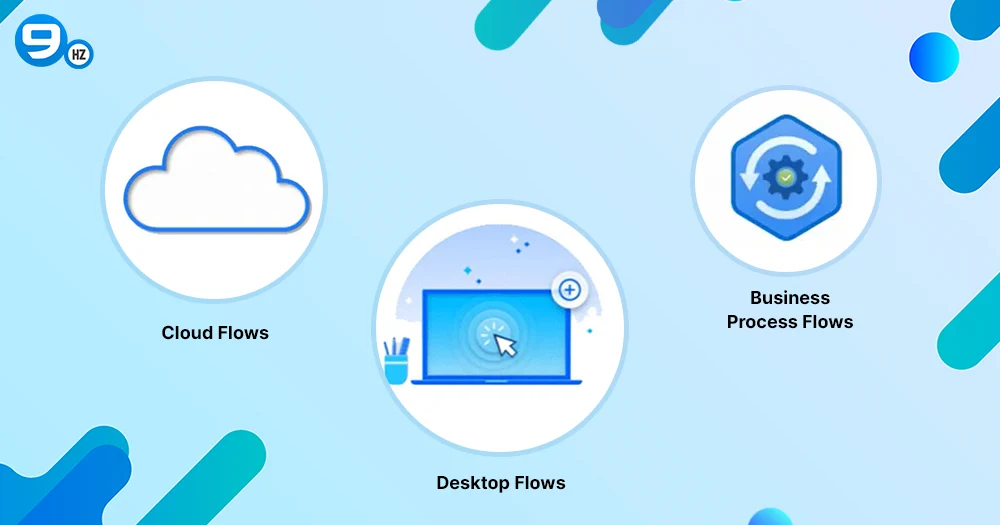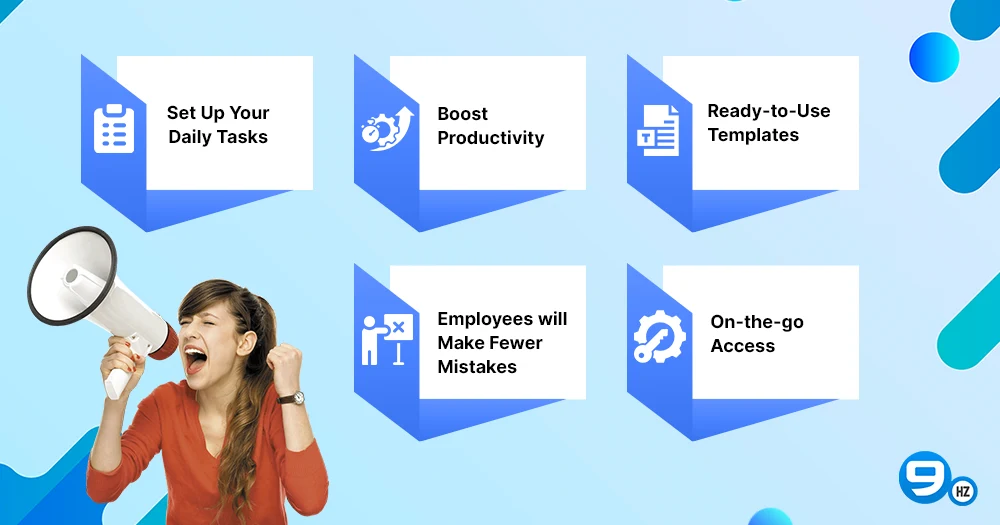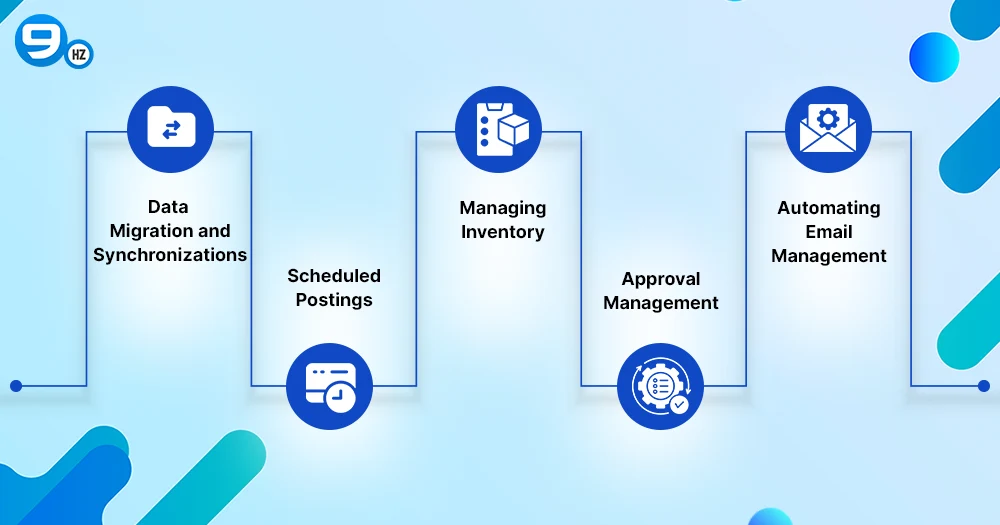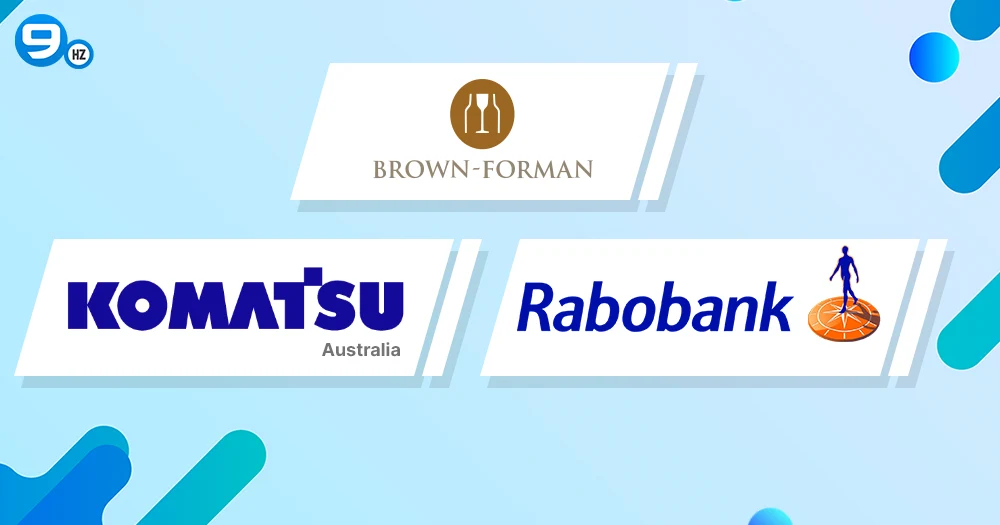Today, IT leaders have started focusing on process automation as a top priority for customer experience through agility and scalability. One of the most powerful tools for achieving this is Microsoft Power Automate. But What is Power Automate? As part of the Microsoft Power Platform, Power Automate brings automation into the flow through AI capabilities. It involves technologies like robotic process automation (RPA), process mining, and digital process automation (DPA), making it a flexible solution for smooth workflows.
According to the 2023 State of Process Orchestration, 96% of organizations believe in digital transformation through process automation. Yet, they find it challenging to access the right tools to accelerate processes and meet the needs of IT teams and end-users.
Power Platform is a automation platform powered by low code and AI that allows enterprises to automate business process, and cut down development costs across your business. Power BI, Power Apps, Power Automate, Power Pages, and Microsoft Copilot Studio are some of the crucial components of the Power platform that accelerate operational workflow.
With Power Automate, unlimited systems can be automated to uncover business opportunities and achieve long-term success. Built-in security, regulatory governance, and robust monitoring help organizations scale confidently.
Still not convinced? In this blog, we will learn the basics and professional understanding of the Microsoft Power Automate services, giving you confidence in your effort to drive innovation.
What is Power Automate?
Microsoft Power Automate(formerly known as Microsoft flow) is a process automation platform that is designed to automate workflow and work across an array of applications. It can trigger action based on the specific event by initiating the sequence of automated actions. With minimal manual intervention, this cloud-based platform attempts to boost user productivity by putting intelligent workflows into practice. This tool is not only for IT members but also for non-IT business leaders to create their own easy-to-use solutions.
One of the most popular power platform tools, Power Automate, possesses a high level of utility. It is intended for automating mundane and time-consuming tasks. Not everyone is 100% sure that they need this tool; however, understanding its uses can help you grasp the functionalities of this platform.
It is a trigger-based model that can run repetitive tasks from anywhere with the help of connected devices and schedule flows when multiple tasks are scheduled. By effectively utilizing Power Automate, you can get loads of work done in minutes and tackle everyday activities with great ease.
Many people often get confused about Power Apps Vs Power Automate. Be sure to check out our blog for a detailed comparison.
What Are Some Features of MS Power Automate?
Power Automate consists of a rich set of features for automating manual activities and orchestrating workflows. They include:
1. Task and Process Mining
With process mining, organizations can identify the business challenges associated with the process. It gives deep understanding about the inefficiencies through event log files. Further, task mining capability helps you in the identification of the specific tasks during process mining. The insightful data can let you aware of the common mistakes while performing tasks through automation.
2. Connectors and Integration
Power Automate offers an extensive library of connectors that allow seamless integration with third-party services and tools like Dynamics 365, SharePoint, and Outlook. With smooth data exchange between the connectors, organizations can ensure end-to-end automation. This eliminates the requirement for custom API integration and accelerates robust automation across multiple platforms.
3. Enterprise-Grade Security
Microsoft Power platform has included enterprise security features in Power Automate to maintain consistent security measures through governance, access controls, and data privacy. For instance, there are data loss prevention (DLP) policies, role-based access controls (RBAC), encryption, and auditing and logging that give confidence to automation by making it aligned with governance standards.
4. Pre-built Templates
It has pre-built flows and templates, including a range of automation scenarios. Users can treat them as a blueprint for quickly customizing and automating tasks based on the triggered action. You can browse your tasks, which can be sending notifications, automated mail, announcements, or integrating with other Microsoft services.
5. Robotic Process Automation (RPA)
Business users can use RPA for Desktop flow, transforming their legacy system with a prebuilt interface. The tasks are automated on the desktop through hosted infrastructure, allowing you to optimize resources and manage peaks. It works by recording your actions or tasks and utilizing the copilot experience while replicating those tasks.
Power Automate is conveniently available on Microsoft Teams and also as a mobile app or website, which allows users to track their triggered actions on the go.
Want to save time on your tasks?
Let us help you to automate business process with Power Automate!
Overview of The Types of Flows in Power Automate
As defined above, Microsoft Power Automate has various pre-defined templates from which to choose for automating flows. These flows are divided into three categories such as:
1. Cloud Flows
The most common type is the cloud flow allowing for automated, instant, and scheduled automation. Let’s explore each subtype with suitable examples and understand the core concept better:
Automated Flows
Automated flows streamline communications between cloud or on-premises services when triggered by specific conditions, such as someone sending an email or noticing a mention on social media.
Instant Flows
With the help of instant flows, you can automate desktop and mobile very easily. They are perfect when it comes to streamlining tasks like requesting approvals in Teams or SharePoint or sending timely reminders to teams through smartphones.
Scheduled Flows
With scheduled flows, tasks are automatically executed based on a predetermined schedule. For example, daily data uploads to SharePoint or Dynamics 365 can be automated by these flows.
2. Desktop Flows (UI Flows)
Desktop flows are crucial when it comes to automating tasks across both desktop and web platforms. Leveraging the potential of Power Automate Desktop will help businesses streamline multiple tasks to maximize productivity. For example, by automating data extraction from competitor websites, desktop flows empower membership organizations to quickly compare offerings, saving valuable time and resources.
3. Business Process Flows
Designed for seamless task execution, business process flows ensure operational consistency across organizations. With Business Process Flows, individuals are guided through defined processes using a user-friendly interface that can be fully customized for various roles within an enterprise. They ensure uniform data entry and adherence to standardized procedures like handling customer service requests or procuring invoice approvals before order submission.
Benefits of Power Automate
The following are some of the reasons why businesses need to use Microsoft Power Automate:
1. Set Up Your Daily Tasks
Numerous daily repetitive tasks hamper your ability to focus on high-priority tasks. Power Automate lets you automate the workflow by scheduling for a specific time, and it will start automatically when it reaches that timeline. After setting the flow, you can forget about them and start focusing on the things that actually matter.
2. Boost Productivity
Microsoft Flow can save time for your employees because of its low-code nature. The codes can be implemented and tested instantly, contributing to boosting workforce productivity. The streamlined approvals, managed communications, and professional on-time documentation will automate the workflow and thereby make employees productive.
3. Ready-to-Use Templates
With pre-built templates, Power Automate can benefit developers who want to improve productivity by saving their time. Many templates are available, so you do not always have to start from scratch. You can create flows for multiple scenarios, helping you make correct decisions.
4. Employees will Make Fewer Mistakes
This platform allows you to automate repetitive and overwhelming tasks once and for all. When it comes to monotonous work, the chances of making mistakes are higher. With Power Automate, the flow needs to be set once, and it will act on its own without being interrupted. This not only minimizes human intervention but also reduces the possibility of human errors. The confidently created flow will ensure a high level of standard.
5. On-the-go Access
Imagine you are not at your desk, and you want to do a task that demands immediate attention. No worries; Microsoft Flow will do that. The Power Automate mobile app gives you accessibility where you go so that you can run your event from any place through the app. You can even check the process automation on your mobile phone while you are away from your desk.
What Are the Use Cases for Power Automate?
Power Automate is a versatile platform utilized in a wide range of industries for automating several workflows. Here are some examples of popular applications:
1. Data Migration and Synchronizations
When you move data across Microsoft services and other external resources, you can employ the flow to ensure a smooth data migration. Likewise, users can ensure up-to-date customer records and manage inventory levels with greater accuracy. This top-notch synchronization will ensure data consistency and less need for manual data entry.
2. Scheduled Postings
Many organizations use Power Automate to schedule and establish social media postings on platforms like Facebook, Twitter, and Instagram. Custom posts, such as a new blog or article, can be created to ensure consistency. Harnessing the post-scheduling feature will facilitate your social media marketing efforts and save time on posting one by one.
3. Managing Inventory
Businesses can implement this flow to supply chain management, where operational managers can identify inventory levels. Automatic reminders and notifications are sent to the managers when stock is over or less than the standard quantity. This information is valuable for retailers and allows them to improve supply chain efficiency with smart decisions.
4. Approval Management
Approval request management, especially for the annual budget or sales deck, will have a huge impact on financial decisions. Power Automate will streamline this process by specifying the person involved in the approval, as the notifications are sent to that person who will take action. You can get visibility on your approval status, which speeds up the process and reduces the bottlenecks.
5. Automating Email Management
Power Automate can be used to send targeted emails to your leads, which later improves retention rates. Use flows to send personalized emails to subscribers at a specific time as part of email marketing efforts. You can manage various kinds of emails, such as payment confirmations, personalized greetings, or welcome mails that build a connection with customers.
How Does Power Automate Work?
This cloud-based service enables users to create automated flows by triggering actions or events or even manual intervention. The pre-built connectors and visual interface are made accessible to technical and non-technical users for customized workflows. This can happen through cloud flows, desktop flows, and business process flows, which can also work together to address the diverse needs of organizations.
The Power Automate can:
- Orchestrate time-consuming workflows
- Synchronizing updates for supporting consistency
- Generate notifications to keep the stakeholders informed
Companies Using Microsoft Power Automate
By now, you already have an idea about how you can adapt to Power Automate for your business needs. Let’s explore some real-world examples of how this platform helps in transforming operations by creating the relevant flows:
Komatsu Australia
Komatsu Australia is a leading manufacturer of construction and mining equipment. This company utilized the potential of Power Automate to automate invoice processing workflow when it faced troubles processing 52,000 invoices manually. This new process, which was actually developed in just three weeks, saved hundreds of hours of labor. As a result, the company processed 1100 invoices, which saved 300 hours of work for a single supplier.
Brown-Forman
Brown-Forman has automated the manual processes through RPA functionality in Power Automate. Their Continuous Improvement Digital Transformation team has driven innovation in the business process to automate low-value tasks, which has saved them thousands of work hours. The team found out that built-in connectors like Salesforce, Google Workspace, and Workday allowed the company to hit the ground. The solution also impressed them from the data consistency point of view as there are automated integrations and real-time data exchange, which previously required a data specialist.
Rabobank
Rabobank, which is the second largest bank in the Netherlands, has chosen Power Apps and Power Automate solutions as default development solutions for automating internal processes. As a part of the Center of Excellence strategy, the solution created a default environment for all users. It would help create basic apps and often create flows for personal productivity. With a new development platform in place, Rabobank is now ready to tackle complex processes like the “employee reorganization process”.
How to Get Started with Power Automate?
To get started, visit the Power Automate website and set up your account. After you sign up, you will be landed on the homepage, where you will see different workflows and connectors. You need to ensure that you have a license to access features and start familiarizing yourself with the key components.
- Explore the pre-existing templates or customize a flow as per your needs
- Define your trigger after selecting the flow type.
- Connect your apps with an array of available connectors like Outlook, Sharepoint, and Dynamics 365.
- Test and configure your created flow, and then click “Save.”
- From “flow history,” you can monitor your flow and stop it whenever you need.
Is Power Automate Right for You?
The suitability of Power Automate software depends upon the automation needs and infrastructure stack currently used in the organization. It is ideal for users who want simple automation and seamless integration with Microsoft services. But if you want an advanced workflow, you can switch to premium, for which you need to analyze your needs.
Advanced automation can provide AI and RPA capabilities with multiple applications for scaling large-scale workflows. However, if your automation requirement is technical and you seek custom workflows, you can use other specialized tools.
Power Automate Pricing
The licensing model of power platform tool, Power Automate, includes free, premium, Power Automate Process, and hosted processes. You need to understand each option to select the most appropriate license model based on your requirements and budget.
| Licensing Model | Price | Details |
|---|---|---|
| Power Automate Free Trial | Free | This offers a 30-day free trial with basic automation capabilities. You can explore the UI-based cloud flows along with standard connectors. |
| Power Automate Premium | $15 per user/month | You will get access to cloud flows, desktop flows, process and task mining, and 250 MB of data entitled in Microsoft Dataverse. |
| Power Automate Process | $150 per bot/month | Gives you accessibility to automate core enterprise processes with unattended automation and 5000 credits of AI Builder. |
| Power Automate Hosted Process | $215 per bot/month | You can automate the core process and run unattended automation that is hosted by Azure infrastructure. |
How The NineHertz Can Help You with Automate and Optimize Business Processes?
The NineHertz empowers many enterprises to fully take advantage of Microsoft suite services. Our power platform development services attempt to deliver solutions that drive innovation and efficiency. At Ninehertz, we believe in undertaking a client-centric approach to integrating complex workflows and ongoing support for driving a smooth digital transformation. With a deep understanding of Power BI, Power Apps, and Power Automate, we ensure excellence in seamless automation and custom development.
Conclusion
In a nutshell, what is Power Automate? Microsoft Power Automate is a powerful tool used by organizations aiming to digitize operations. A user-friendly interface, pre-built templates, a vast library of connectors, and a diverse feature set will make your organization ready to tackle the challenges of the digital age. Certainly, it is a valuable investment for boosting business processes with reduced human errors. The AI enhancements and high-standard integration services enable businesses to revolutionize application development and also take process automation to the next level.
Frequently Asked Questions on What is Power Automate(FAQs)
What is a Power Automate used for?
Power Automate is a cloud-based service that is used to automate repetitive and monotonous tasks to boost efficiency by creating workflow.
What is a Microsoft Power Automate free license?
Microsoft Power Automate’s free license provides access to basic features to create and run cloud flow with standard connectors only, but can’t share them. You can also get free license with any other products of Microsoft.
What is the difference between Power Automate and flow?
Power Automate was formerly known as Microsoft Flow. It was rebranded in November 2019, but it’s the same product with the same functionality, now known as Power Automate.
Great Together!

